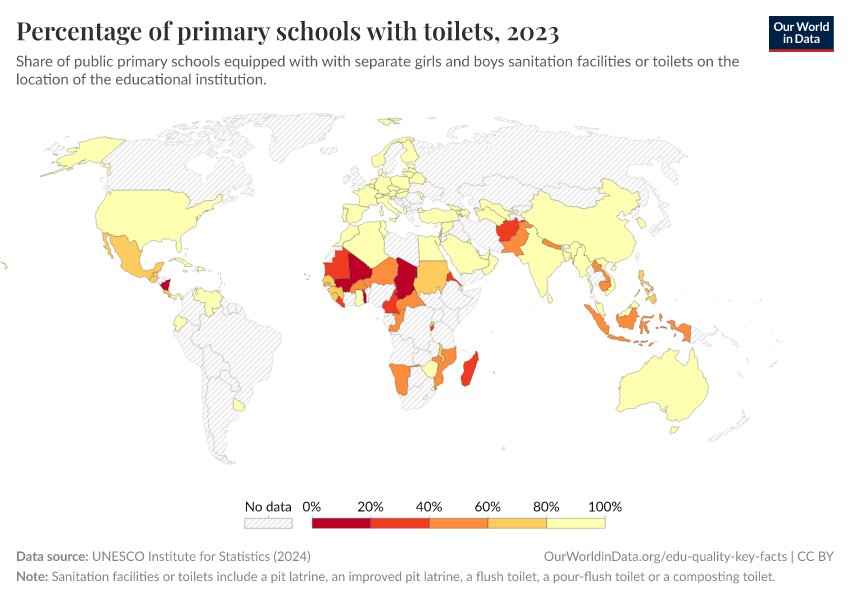Share of primary schools with toilets

What you should know about this indicator
- Access to separate toilets for girls and boys is essential for dignity, privacy, and hygiene — this indicator shows how many primary schools provide this basic facility.
- It measures the proportion of primary schools with basic sanitation facilities that are single-sex, meaning there are separate, usable toilets for male and female students on site.
- Basic sanitation facilities include functional and private toilets that hygienically separate human waste from human contact and are not shared with other buildings or the public.
- A high percentage indicates better readiness of the school system to provide a safe and inclusive learning environment, especially for girls, who may be more likely to miss school without such facilities.
- The data is typically collected through national school censuses or Education Management Information Systems (EMIS) and is reported by school officials.
- Disaggregating this indicator by urban/rural location, region, or public/private management can help identify disparities in access to gender-sensitive school infrastructure.
- Some limitations include potential discrepancies in how countries define or report "usable" or "functional" toilets, and whether cleanliness, maintenance, or disability access are accounted for.
What you should know about this indicator
- Access to separate toilets for girls and boys is essential for dignity, privacy, and hygiene — this indicator shows how many primary schools provide this basic facility.
- It measures the proportion of primary schools with basic sanitation facilities that are single-sex, meaning there are separate, usable toilets for male and female students on site.
- Basic sanitation facilities include functional and private toilets that hygienically separate human waste from human contact and are not shared with other buildings or the public.
- A high percentage indicates better readiness of the school system to provide a safe and inclusive learning environment, especially for girls, who may be more likely to miss school without such facilities.
- The data is typically collected through national school censuses or Education Management Information Systems (EMIS) and is reported by school officials.
- Disaggregating this indicator by urban/rural location, region, or public/private management can help identify disparities in access to gender-sensitive school infrastructure.
- Some limitations include potential discrepancies in how countries define or report "usable" or "functional" toilets, and whether cleanliness, maintenance, or disability access are accounted for.
Sources and processing
This data is based on the following sources
How we process data at Our World in Data
All data and visualizations on Our World in Data rely on data sourced from one or several original data providers. Preparing this original data involves several processing steps. Depending on the data, this can include standardizing country names and world region definitions, converting units, calculating derived indicators such as per capita measures, as well as adding or adapting metadata such as the name or the description given to an indicator.
At the link below you can find a detailed description of the structure of our data pipeline, including links to all the code used to prepare data across Our World in Data.
Reuse this work
- All data produced by third-party providers and made available by Our World in Data are subject to the license terms from the original providers. Our work would not be possible without the data providers we rely on, so we ask you to always cite them appropriately (see below). This is crucial to allow data providers to continue doing their work, enhancing, maintaining and updating valuable data.
- All data, visualizations, and code produced by Our World in Data are completely open access under the Creative Commons BY license. You have the permission to use, distribute, and reproduce these in any medium, provided the source and authors are credited.
Citations
How to cite this page
To cite this page overall, including any descriptions, FAQs or explanations of the data authored by Our World in Data, please use the following citation:
“Data Page: Share of primary schools with toilets”, part of the following publication: Hannah Ritchie, Veronika Samborska, Natasha Ahuja, Esteban Ortiz-Ospina, and Max Roser (2023) - “Global Education”. Data adapted from UNESCO Institute for Statistics. Retrieved from https://archive.ourworldindata.org/20250909-093708/grapher/percentage-of-primary-schools-with-toilets.html [online resource] (archived on September 9, 2025).How to cite this data
In-line citationIf you have limited space (e.g. in data visualizations), you can use this abbreviated in-line citation:
UNESCO Institute for Statistics (2025) – with minor processing by Our World in DataFull citation
UNESCO Institute for Statistics (2025) – with minor processing by Our World in Data. “Share of primary schools with toilets” [dataset]. UNESCO Institute for Statistics, “UNESCO Institute for Statistics (UIS) - Education” [original data]. Retrieved November 4, 2025 from https://archive.ourworldindata.org/20250909-093708/grapher/percentage-of-primary-schools-with-toilets.html (archived on September 9, 2025).